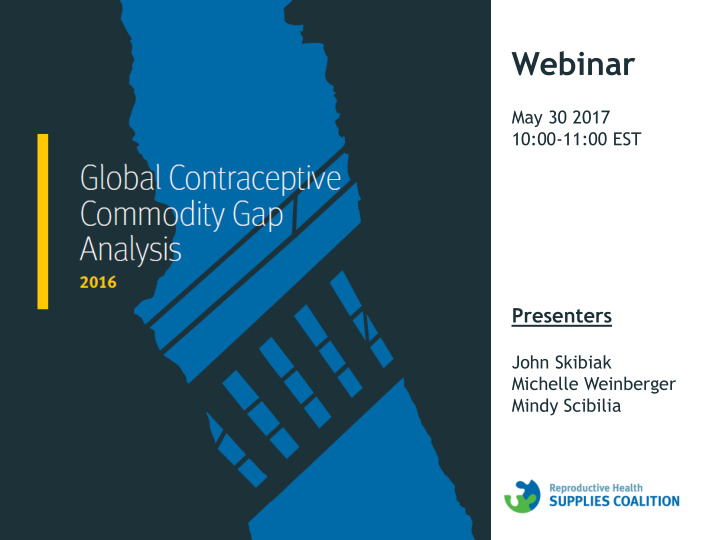



Webinar May 30 2017 10:00-11:00 EST Presenters John Skibiak Michelle Weinberger Mindy Scibilia
Agenda Introduction CGA 2016 key findings | emphasis on 69 FP2020 focus countries - Spending on contraceptive supplies - Number of users of each method - Consumption quantities - Consumption costs - Projected gaps Analysis: procurement requests for 20 countries Questions and comments CONTRACEPTIVE COMMODITY GAP ANALYSIS 2016
Context and Purpose CGA 2016 offers new insights into contraceptive commodity consumption and future needs: method mix, quantity, and cost Data and analyses developed by many different RHSC partners were combined or sequenced to produce final report; knowledge-sharing and greater transparency encouraged CGA 2016 looks at total market – public and private sectors – and all modern contraceptive methods. It provides information for multiple audiences, including advocates, donors, manufacturers, experts, decision-makers Advisory group and stakeholder consultation provided critical guidance in shaping the CGA 2016 CONTRACEPTIVE COMMODITY GAP ANALYSIS 2016
Four driving questions CONTRACEPTIVE COMMODITY GAP ANALYSIS 2016
CGA 2016: Key Findings Michelle Weinberger Senior Associate, Avenir Health CONTRACEPTIVE COMMODITY GAP ANALYSIS 2016
Getting to answers with the CGA 2016 Scope Scenarios/Analysis Results 135 Low and Middle 2014 spending on • • Users (by method) • Income Countries commodities Consumption quantities • A: current trends • • Cost of consumption 69 FP2020 Focus continue to 2020 • Additional spending • Countries • B: FP2020 goal met by needed 2020 • 20 country aggregate procurement analysis from quantification Can look at Can focus on specific reports additional subsets of results- e.g. look at countries – e.g. GFF scenarios for Countries implant growth CONTRACEPTIVE COMMODITY GAP ANALYSIS 2016
How much is spent on contraceptive supplies, and what 1 are the relative contributions of donors, governments of low- and middle-income countries, and individuals? 69 FP2020 Countries 135 LMI Countries CONTRACEPTIVE COMMODITY GAP ANALYSIS 2016
How many women will use each method of 2 contraception in 2020, and what volume of supplies will they consume? Results for 69 FP2020 Focus Countries CONTRACEPTIVE COMMODITY GAP ANALYSIS 2016
How much do the supplies consumed by all users of 3 contraception currently cost, and how much greater will the cost be in the year 2020? Results for 69 FP2020 Focus Countries CONTRACEPTIVE COMMODITY GAP ANALYSIS 2016
4 What contraceptive supplies funding gap can we anticipate in the year 2020? Results for 69 FP2020 Focus Countries CONTRACEPTIVE COMMODITY GAP ANALYSIS 2016
If donor and government spending does not increase, 4 what cost burden will shift to out-of-pocket expenditures by individuals? Results for 69 FP2020 focus countries 2020 Scenario A In 2014, spending by the public sector • made up 46% of the total amount spent on commodities • If annual public sector spending does not increase, the additional cost burden will shift to individuals. This means 2020 Scenario B more women paying for their own contraceptives, in both absolute and relative terms. Under Scenario A , the public sector • would account for just 36% of total spending. Under Scenario B , it would account for just 30% . CONTRACEPTIVE COMMODITY GAP ANALYSIS 2016
Cost burden shift: 69 FP2020 focus countries What happens if annual public sector spending on supplies remains constant at the 2014 level - $374,700,000 - from 2016 to 2020? Scenario A If current trajectories continue, individual spending on contraceptive supplies must grow from $447 million in 2014 to $680 million in 2020. This is an increase of $233 million in spending by individuals in 2020 alone. Scenario B To achieve the FP2020 goal without any increase in public sector funding for supplies, individual spending must grow from $447 million in 2014 to $884.5 million in 2020. This is an increase of more than $437 million in 2020 alone -- nearly double the amount individuals spent in in 2014. CONTRACEPTIVE COMMODITY GAP ANALYSIS 2016
CGA 2016: Procurement funding needs for 20 countries Mindy Scibilia Global Family Planning Program Manager, CHAI CONTRACEPTIVE COMMODITY GAP ANALYSIS 2016
Analysis: Public Sector Procurement Funding The procurement analysis addresses a different question... For 20 FP2020 countries, how much funding will be needed for public sector procurement each year from 2016 to 2020? ... So it uses different methodologies and data sources: country quantification reports and supply plans Procurement quantities differ from consumption quantities: Consumption quantities refer to the amount of products an individual must consume for one year of protection from unintended pregnancy Procurement quantities must account not only for the products individuals will consume but also the inventory required throughout the supply chain. CONTRACEPTIVE COMMODITY GAP ANALYSIS 2016
Estimated public sector procurement funding gaps for 20 countries Total public sector spending on supplies in 2014: $ 166 million Total public sector funding needed in 2016: $ 210 million Gap: $ 45 million $ 337 million Gap: $ 171 million Total public sector funding needed in 2020: CONTRACEPTIVE COMMODITY GAP ANALYSIS 2016
Looking Ahead: 2017 and beyond Coming soon: Interactive online data tool for CGA 2016 estimates B riefs on findings for subsets of countries and regions | “bespoke” analyses by method, sector, or country grouping CGA to be updated annually: Refreshed data on contraceptive use Analysis of spending in 2015 Key point from CGA 2016: if public sector spending does not increase, a prerequisite to achieving the FP2020 goal will be the near doubling of individual out-of-pocket spending on contraceptive supplies CGA 2017 will examine individual spending more closely, consumer prices as barrier to access CONTRACEPTIVE COMMODITY GAP ANALYSIS 2016
Recommend
More recommend